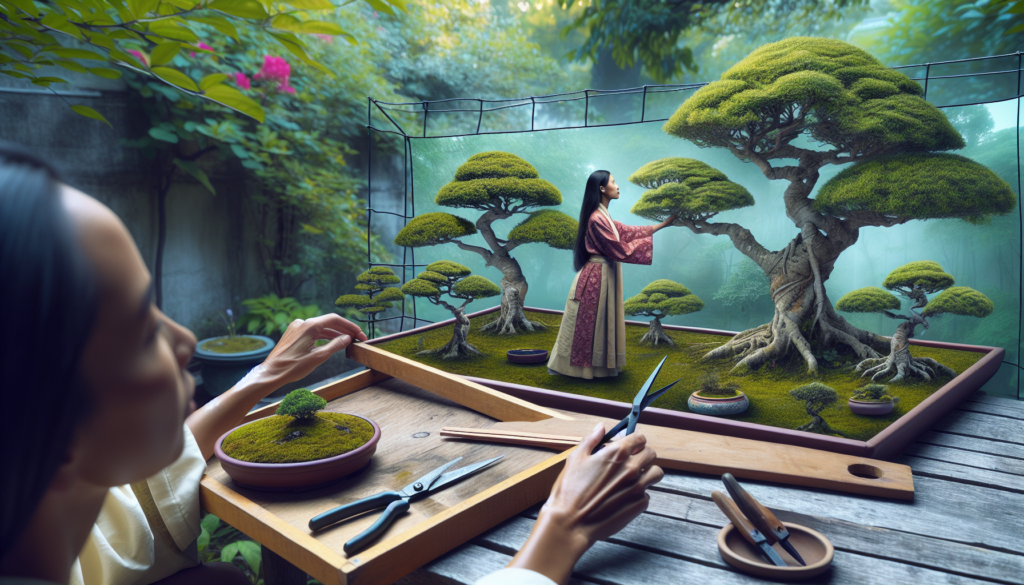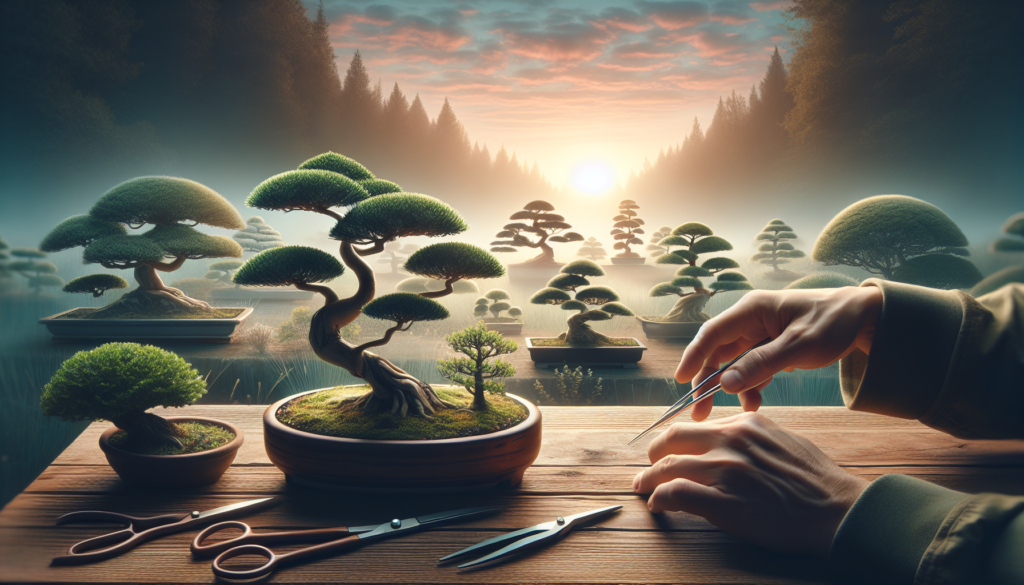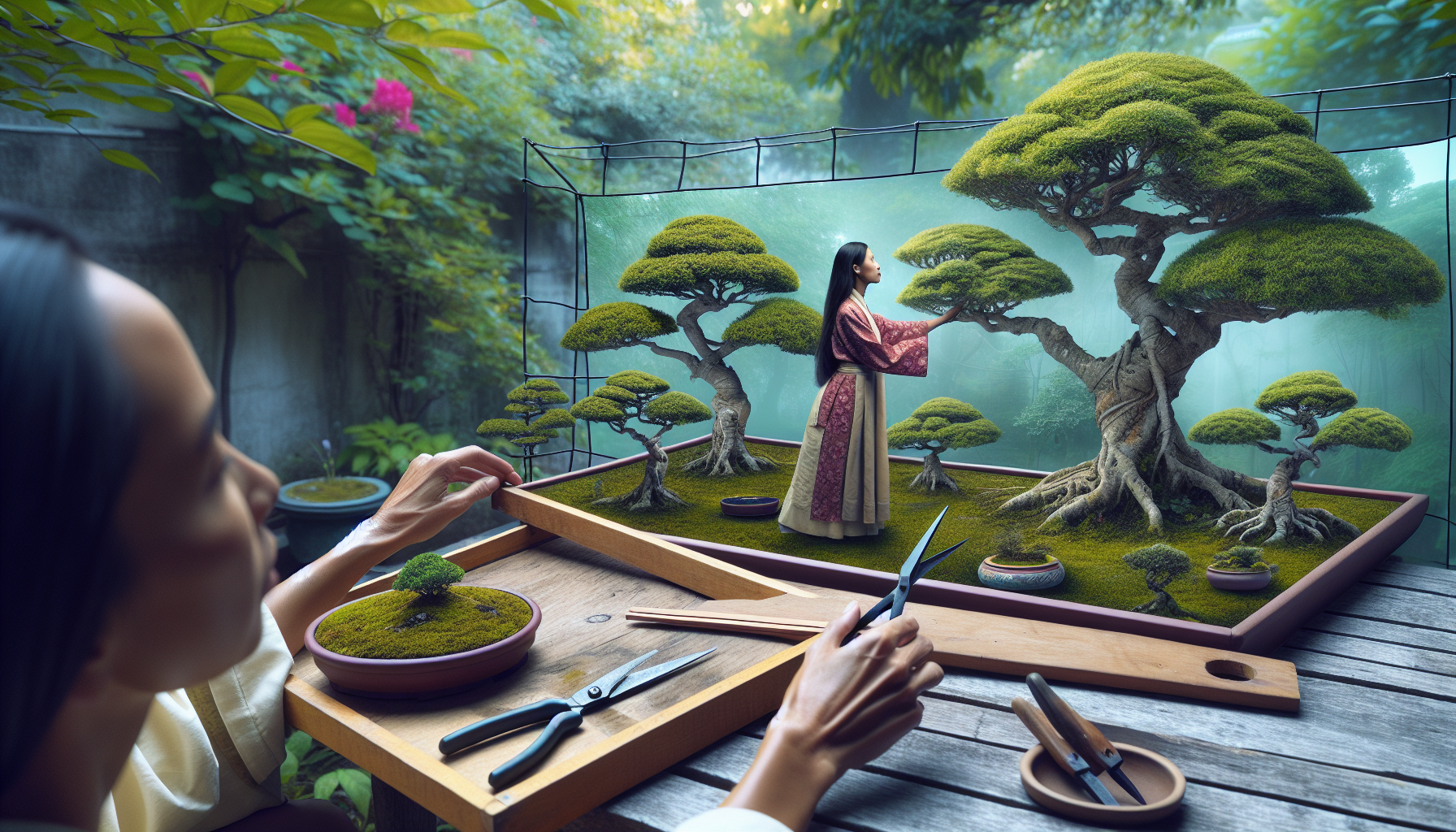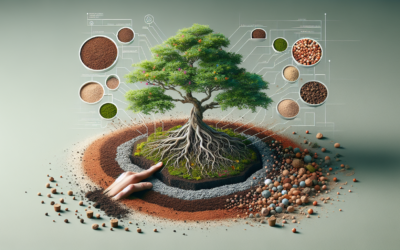Are you looking to find a new, unique way to relax and unwind? Look no further than Bonsai cultivation. This art form originating from Japan involves growing and nurturing miniature trees in pots, and it has been found to have remarkable therapeutic benefits. In this article, we will explore how cultivating bonsai trees can help reduce stress, improve focus, and promote mindfulness. So sit back, relax, and prepare to discover the hidden secrets of bonsai therapy.
What is Bonsai?
Bonsai is the art of cultivating miniature trees in pots, creating a scaled-down representation of nature. The word “bonsai” itself means “tray planting” in Japanese, highlighting the practice of shaping and tending to the small plants to mimic the appearance of mature, full-sized trees. Bonsai requires careful pruning, wiring, watering, and other techniques to maintain the desired shape and size of the tree. It is a practice that originated in ancient China and was later adopted and refined by the Japanese.
Definition of Bonsai
Bonsai can be defined as the art of growing and training small, potted trees in order to create a visually appealing miniature representation of nature. The aim is to create a harmonious and balanced composition that reflects the characteristics and beauty of full-sized trees. Bonsai trees are carefully shaped and pruned to mimic the appearance of mature trees, and they require ongoing care and maintenance to ensure their health and longevity.
History and Origins of Bonsai
The art of bonsai has its roots in ancient China, where it was practiced as early as the 6th century CE. It was later embraced and refined by the Japanese, who developed their own unique styles and techniques. Bonsai was initially associated with religious and philosophical beliefs, representing the balance between nature and humanity. Over time, it evolved into an art form accessible to anyone interested in cultivating miniature trees. Today, bonsai is practiced and appreciated worldwide, with enthusiasts and artists continuously pushing the boundaries of creativity and innovation in the pursuit of bonsai perfection.
Different Styles in Bonsai
Bonsai art encompasses various styles, each with its own distinct characteristics and aesthetics. Some of the most popular styles include:
- Formal Upright (Chokkan): A straight and upright form, with tapering branches and a well-defined trunk.
- Informal Upright (Moyogi): A more curved and natural-looking style, with a slightly inclined trunk and a more relaxed appearance.
- Slanting (Shakan): Characterized by a noticeable slant or lean to one side, creating a sense of movement and dynamism.
- Cascade (Kengai): The tree’s branches and foliage flow downward, mimicking the appearance of a tree growing on a steep cliff or by a riverbank.
- Windswept (Fukinagashi): Evoking the image of a tree shaped by strong winds, with branches bending in the same direction to show the effects of nature’s forces.
- Literati (Bunjin): A unique style featuring a slender and sinuous trunk with sparse foliage, often symbolizing the pursuit of spiritual enlightenment.
Understanding the Concept of Bonsai as Therapy
The Psychological Benefits of Gardening
Gardening has long been known to have positive psychological effects on individuals. It provides a sense of purpose, connection to nature, and an opportunity for nurturing and creating life. Engaging in gardening activities can reduce stress, anxiety, and depression while promoting relaxation and a sense of well-being. The act of tending to plants and watching them grow can bring a sense of accomplishment and satisfaction, boosting one’s mood and self-esteem.
Formation of the Idea of Bonsai as Therapy
The concept of bonsai as therapy stems from the recognition of the psychological benefits associated with gardening. As the art of bonsai requires time, patience, and care, it naturally lends itself to an activity that can foster a sense of calm and tranquility. The process of shaping and maintaining a bonsai tree requires focus and concentration, allowing individuals to become fully immersed in the present moment. The aesthetic beauty of bonsai and the satisfaction derived from creating a living work of art can provide a sense of purpose, fulfillment, and emotional well-being.
Cases and Evidence Supporting Bonsai as Therapy
Numerous cases and anecdotal evidence support the therapeutic benefits of bonsai cultivation. Many individuals have shared their personal experiences of finding solace, stress relief, and a renewed sense of purpose through bonsai. The act of carefully tending to a miniature tree, observing its growth and responding to its needs, can provide a sense of control and mastery over one’s environment. Bonsai enthusiasts often report feeling a deep connection to nature and a sense of peace when engaged in the art form. Additionally, research studies have shown that spending time in nature, even on a small scale with bonsai, can improve overall well-being and reduce symptoms of depression and anxiety.

Psycho-Emotional Benefits of Bonsai Cultivation
Bonsai and Meditation
Bonsai cultivation can be seen as a form of meditation, allowing individuals to enter a state of mindfulness and calm. The act of carefully pruning and shaping the tree requires focused attention and concentration, similar to the practice of meditation. As the mind becomes absorbed in the task at hand, worries and concerns can fade away, providing a much-needed mental break from daily stresses. Bonsai also encourages individuals to slow down and observe the intricate details of nature, fostering a sense of appreciation and wonder.
Stress Relief
The act of tending to bonsai has been shown to have stress-relieving effects. Engaging in this hands-on activity allows individuals to shift their focus from everyday pressures to the task of caring for the tree. The repetitive motions of pruning, wiring, and watering can induce a state of relaxation and promote a sense of calm. As bonsai cultivators immerse themselves in the process, the mind can unwind, and stress levels can decrease. Additionally, the sense of accomplishment and joy derived from nurturing a bonsai tree can counteract feelings of anxiety and tension.
Boosting Self-Esteem and Confidence through Bonsai Mastery
The mastery of bonsai techniques and the successful cultivation of healthy trees can boost self-esteem and confidence. As individuals progress in their bonsai journey, they acquire new skills and knowledge, leading to a sense of accomplishment. Creating a beautiful bonsai tree requires patience, dedication, and attention to detail, and the ability to see the tree’s potential. As bonsai artists witness the growth and transformation of their trees over time, they gain a deeper understanding of their own capabilities and potential for personal growth, thereby enhancing self-esteem and confidence.
Cultivating Patience through Bonsai Art
Patience is a virtue that can be cultivated through the art of bonsai. Growing a bonsai tree requires time and patience, as it takes years, sometimes even decades, for a tree to develop into its desired form. Bonsai artists must learn to wait, observe, and respond to the tree’s needs without rushing the process. This cultivation of patience can extend beyond the realm of bonsai and positively impact other areas of life. Learning to embrace the slow pace of growth and accepting that things take time can lead to a greater sense of peace and contentment.
Physical Health Benefits of Cultivating Bonsai Trees
Exercise and Mobility
Cultivating bonsai trees involves physical activities such as bending, lifting, and maneuvering small pots and tools. These movements can contribute to improved flexibility, strength, and overall mobility. Working on bonsai trees also encourages individuals to spend time outdoors and engage in light physical exercise, contributing to a healthier lifestyle. The combination of physical activity and the therapeutic nature of bonsai can have positive effects on one’s fitness and well-being.
Improvement of Cognitive Abilities
Engaging in the art of bonsai can provide cognitive benefits, such as improved focus, concentration, and problem-solving skills. The process of shaping and maintaining a bonsai tree requires careful observation, decision-making, and attention to detail. As individuals navigate the complexities of bonsai cultivation, they exercise their cognitive abilities and enhance their mental acuity. This can have broader implications for cognitive health, potentially improving memory, attention span, and overall cognitive function.
Enhancement of Fine Motor Skills
The intricate work involved in caring for bonsai trees can enhance fine motor skills. Pruning, wiring, and repotting require precise movements and delicate manipulation of tools. Through regular practice, individuals can develop dexterity, hand-eye coordination, and fine motor control. These skills are not only valuable in bonsai cultivation but can also extend to other areas of life, enhancing abilities in tasks that require precision and manual dexterity.

Social Perks of Engaging in Bonsai Art
Bonding over a Shared Interest
Bonsai cultivation provides an opportunity for individuals to connect and bond over a shared interest. Bonsai enthusiasts often form communities and clubs where they can exchange knowledge, share experiences, and offer support to fellow bonsai growers. The shared passion for bonsai creates a sense of camaraderie, allowing individuals to connect on a deeper level and establish meaningful relationships. The social aspect of bonsai art can be particularly beneficial for individuals seeking companionship, a sense of belonging, and a support network.
Networking with Fellow Bonsai Growers
Engaging in bonsai art opens doors to networking opportunities within the bonsai community. Bonsai enthusiasts often attend workshops, exhibitions, and conferences where they can meet experienced growers, experts, and artists. These interactions provide a platform for learning, exchanging tips and techniques, and gaining insights into the art form. Networking with fellow bonsai growers can foster personal and professional growth, expanding one’s knowledge and exposure to new ideas and perspectives.
Bonsaists Meetups and Exhibitions
Bonsai enthusiasts regularly organize meetups, exhibitions, and shows, providing a platform for individuals to showcase their bonsai creations and appreciate the artistry of others. These gatherings not only promote a sense of community but also create opportunities for learning and inspiration. Attending bonsai exhibitions allows individuals to witness the diversity and beauty of bonsai trees, fueling creativity and providing a platform for appreciation and growth. These events can be highly motivating and encourage individuals to further explore the art of bonsai.
Bonsai and Mindfulness Practice
Practicing Mindfulness through Bonsai Cultivation
Bonsai cultivation lends itself naturally to the practice of mindfulness. Mindfulness involves paying attention to the present moment, without judgment or distraction. When tending to bonsai trees, individuals focus on the task at hand, observing the intricate details, and responding to the needs of the tree. This focused attention brings awareness to the present moment and can facilitate a sense of calm and serenity. Bonsai practitioners can use this time to cultivate mindfulness, letting go of worries and concerns, and fully immersing themselves in the art of bonsai.
Bonsai and the Concept of Wabi-Sabi
The concept of wabi-sabi, rooted in Japanese aesthetics and philosophy, aligns closely with the art of bonsai. Wabi-sabi celebrates imperfection, transience, and the beauty of the imperfect and the incomplete. Bonsai trees, with their rugged bark, twisted branches, and weathered appearance, embody the essence of wabi-sabi. Cultivating bonsai allows individuals to embrace the imperfections and unique characteristics of each tree, fostering an appreciation for the beauty that can be found in simplicity and impermanence. This mindset can extend beyond bonsai, influencing one’s perspective on life, relationships, and personal growth.
Living in the Moment with Bonsai
Bonsai offers an opportunity to slow down, appreciate the beauty of nature, and live in the present moment. As individuals tend to their bonsai trees, they are reminded of the ever-changing nature of life and the importance of cherishing each moment. The process of shaping and maintaining bonsai trees encourages individuals to be fully present and engaged, allowing them to escape the distractions and pressures of daily life. By immersing themselves in the art of bonsai, individuals can find a sanctuary where they can reconnect with themselves and the natural world.
Getting Started with Bonsai – Beginner’s Guide
Choosing Your First Bonsai
Choosing the right bonsai tree for beginners is crucial to ensure a successful start. It’s important to consider factors such as the species of tree, its care requirements, and the level of experience needed to cultivate it. Some beginner-friendly bonsai species include the Chinese elm, juniper, and ficus. These trees are resilient, forgiving, and adaptable to different environments. It’s also essential to select a tree that matches personal preferences in terms of style, aesthetic, and the desired level of care and maintenance.
Initial Care for Your Bonsai
Proper care and maintenance are vital to the health and longevity of bonsai trees. After selecting a bonsai tree, it’s important to learn about its specific care requirements, including watering, lighting, fertilizing, and pruning. Providing the right balance of sunlight, water, and nutrients is crucial for the tree’s growth and development. Beginners should also learn about the proper techniques for repotting, wiring, and shaping their bonsai trees to maintain their desired form.
Common Challenges and How to Overcome
Like any hobby or art form, bonsai cultivation comes with its own set of challenges. Beginners may face difficulties in understanding specific care requirements, identifying and addressing plant health issues, and achieving the desired shape and aesthetics. Patience and perseverance are key in overcoming these challenges. Seeking guidance from experienced bonsai growers, joining bonsai clubs or online communities, and attending workshops can provide valuable advice and support. It’s important to remember that bonsai art is a continuous learning process, and with time and practice, one can overcome these challenges and achieve beautiful results.
Bonsai Tree Maintenance for Therapeutic Results
Trimming and Pruning
Regular trimming and pruning are essential for maintaining the shape, size, and health of bonsai trees. Pruning helps control the growth of branches and foliage, promotes a balanced appearance, and encourages back-budding for denser foliage. Trimming involves removing excess growth, dead or diseased branches, and shaping the tree according to the desired style. These maintenance tasks not only contribute to the aesthetics of the tree but also provide a therapeutic activity that promotes focus, concentration, and a sense of control.
Repotting the Bonsai Tree
Repotting is a crucial aspect of bonsai care and should be performed periodically to ensure the health and vitality of the tree. Repotting involves carefully removing the tree from its pot, trimming the root system, and replanting it in fresh, well-draining soil. This process helps prevent root-bound conditions, allows for the replenishment of nutrients, and promotes new growth. The act of repotting can be therapeutic, as it requires careful observation, careful handling of the tree, and a connection to the tree’s well-being.
Watering and Feeding Bonsai Tree
Regular watering and feeding are essential for the health and growth of bonsai trees. Watering should be done carefully, allowing the soil to dry out slightly between waterings to promote root growth and prevent root rot. The frequency and amount of water needed will vary depending on the species of bonsai tree, the climate, and the time of year. Feeding bonsai trees with a balanced fertilizer helps provide essential nutrients for growth, maintaining the overall health and vigor of the tree. The act of watering and feeding bonsai trees provides an opportunity for nurturing and caring for the tree, promoting a sense of responsibility and connection.
Personal Stories of Healing through Bonsai
Inspiring Personal Experiences
Many individuals have experienced healing and personal growth through the art of bonsai. Countless personal stories demonstrate the transformative power of cultivating bonsai trees. People have found solace, stress relief, and a renewed sense of purpose through their connection to nature and the hands-on care of their bonsai trees. Bonsai has been described as a form of therapy, providing a pathway to self-discovery, mindfulness, and emotional well-being. These personal experiences highlight the immense therapeutic value of bonsai cultivation in enhancing the quality of life and promoting personal growth.
Interviews with Long-Time Bonsai Growers and Therapists
Interviews with experienced bonsai growers and therapists specializing in horticultural therapy can provide valuable insights into the therapeutic benefits of bonsai. Expert practitioners can share their personal journeys, the challenges they have faced, and the rewards they have experienced through bonsai cultivation. They can shed light on the emotional, mental, and physical benefits individuals can gain from engaging in this art form. These interviews can inspire and educate others about the healing potential of bonsai and the ways in which this practice can be integrated into therapeutic settings.
From Casual Grower to Bonsai Artisan – Success Stories
Success stories of individuals who have gone from being casual bonsai enthusiasts to accomplished bonsai artisans can provide inspiration and motivation for others. These stories often highlight the transformative power of the art form and the personal growth that can be achieved through dedication and practice. They demonstrate the resilience, patience, and commitment required to master the techniques of bonsai cultivation and create stunning works of living art. By sharing these success stories, individuals can be inspired to embark on their own bonsai journey and discover the therapeutic benefits of this ancient art form.
The Future of Bonsai as a Therapeutic Activity
Bonsai in Mental Health and Therapeutic Settings
As awareness of the therapeutic benefits of bonsai cultivation continues to grow, its integration into mental health and therapeutic settings is becoming more prevalent. Bonsai can be utilized as a therapeutic activity in hospitals, rehabilitation centers, and wellness programs to promote relaxation, stress reduction, and emotional well-being. The hands-on nature of bonsai allows individuals to engage in mindful and creative activities, fostering a sense of purpose and achievement. Bonsai can complement traditional therapeutic approaches and provide a unique avenue for self-expression, personal growth, and healing.
Research on Bonsai Therapy
While there is anecdotal evidence supporting the therapeutic benefits of bonsai cultivation, further research is needed to explore its effectiveness and potential applications. Research studies can provide empirical evidence on the psychological, emotional, and physical impacts of engaging in bonsai as therapy. This research can help establish guidelines and best practices for incorporating bonsai into therapeutic settings, ensuring its efficacy and safety. By building a body of evidence, bonsai therapy can gain recognition as a valid and valuable therapeutic activity.
Potential Developments in Bonsai as Therapy
The future of bonsai as therapy holds exciting possibilities for further development and innovation. With advancements in technology, individuals may have access to virtual bonsai experiences, allowing them to engage in the art form from the comfort of their own homes. The integration of virtual reality and augmented reality technologies can provide immersive experiences and enhance the therapeutic benefits of bonsai cultivation. Additionally, collaborations between bonsai artists and therapists can lead to the development of specialized programs and activities that focus on specific therapeutic goals, catering to individual needs and preferences.
Bonsai as therapy has proven to be an art form that brings not only aesthetic beauty but also immense psychological, emotional, physical, and social benefits. The art of cultivating and caring for miniature trees offers a form of therapy that promotes mindfulness, stress relief, self-esteem, and enhances cognitive abilities. Bonsai cultivation provides a pathway to connection with nature and oneself, fostering a sense of purpose, patience, and personal growth. As the therapeutic potential of bonsai continues to be recognized and researched, its integration into mental health and therapeutic settings can provide individuals with a unique and powerful tool for healing and well-being. The future of bonsai as therapy holds great promise for further advancements, innovation, and increased accessibility, ensuring that the therapeutic benefits of this ancient art form can be experienced by individuals from all walks of life.








